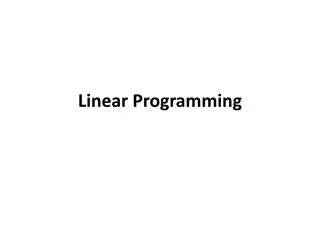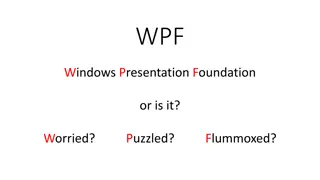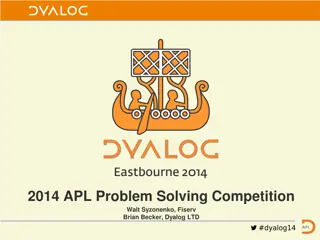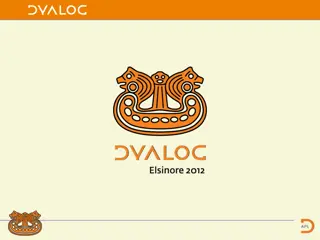Introduction to Mathematical Programming in APL
Explore the world of mathematical programming in APL with a focus on linear programming, decision variables, objective functions, and constraints. Discover the utility of APL syntax for LP/NLP and delve into practical examples such as optimizing production for Blue Ridge Hot Tubs to maximize profit. Unveil the power of APL in handling mathematical programming challenges effectively.
Download Presentation

Please find below an Image/Link to download the presentation.
The content on the website is provided AS IS for your information and personal use only. It may not be sold, licensed, or shared on other websites without obtaining consent from the author. Download presentation by click this link. If you encounter any issues during the download, it is possible that the publisher has removed the file from their server.
E N D
Presentation Transcript
Taming Mathematical Programming in APL (TaMPA) Stephen M. Mansour, PhD, Misericordia University Dyalog 22, Olhao, Portugal October 12, 2022
Dyalog App Library TAMSTAT TAMing STATistics Package New features include Non-Parametric Statistics New Anova Designs Theoretical Probability Graphics ADAGE A Dyalog APL Generalized Equation Solver TAMSTOP TAMing STock OPtions TaMPA Taming Mathematical Programming in APL
What is Mathematical Programming (MP)? A mathematical program (MP) has three components: 1. Decision Variables e.g. How much product to make ?1,?2, ,?? 2. Objective Function - e.g. profit ? ?1,?2, ,?? 3. Constraints e.g. resource limitations ???1,?2, ,?? ?? Linear Programming (LP) is a special case of mathematical programming where ? ?1,?2, ,?? = ?=1 ????, and ???1,?2, ,?? = ?=1 ?????. ? ?
Linear Programming In linear programming we can replace summations with matrix notation. The matrix notation for linear programming (LP) is: max ? Where c is the vector of coefficients in the objective function, A is a matrix of coefficients for the constraints, b is a vector of resource limitations, and x is a vector of decision variables. APL is a natural way to handle linear programming due to its array handling capabilities. ? ? subject to ?? ?
APL Syntax for LP/NLP We propose the following syntax for linear programming (LP) or (NLP) : NS optimize c x subjectTo A x b NS optimize f x subjectTo G x 0 --------- -------------- ------------------ --------- --- Result Runs the builds a creates a right Namespace LP/NLP tableau namespace arg maximize optimize Monadic operator with left minimize optimize oper. produces max or min Key: Array Function Operator NameSpace
Example 1: Blue Ridge Hot Tubs Hot Tub Brand: Unit Profit: Aqua-Spa Hydro-Luxe Typhoon- Lagoon $320 Resources Available: $350 $300 Pumps Required Labor Required Tubing Needed 1 1 1 200 pumps 9 hours 6 hours 8 hours 1566 hours 12 feet 16 feet 13 feet 2880 feet
Questions to ask How many hot tubs of each type should Blue Ridge produce? What is the maximum profit? How much additional profit can be realized with additional resources? What are the costs of deviating from the optimal solution? This Photo by Unknown Author is licensed under CC BY
Problem formulation in mathematical notation ?1= Number of Aqua-Spas to produce ?2= Number of Hydro-Luxes to produce ?3= Number of Typhoon-Lagoons to produce Let ?1 ?2 ?3 350 300 320 ? = ? = Maximize 350?1+ 300?2+ 320?3 Subject to: ?1+ ?2+ 9?1+ 6?2+ 8?3 1,566 12?1+ 16?2+ 13?3 2,880 1 9 1 6 16 1 8 200 1566 2880 ?3 200 ? = ? = 12 13 ?1,?2,?3 0 Maximize ? ? subject to ?? ?
Problem formulation using TAMPA c 350 300 320 Objective coefficients A 3 3 1 1 1 9 6 8 12 16 13 Constraint coefficients 1 1 1 9 6 8 12 16 13 b 200 1566 2880 Resource limitations NS maximize c x subjectTo A x b Perform the LP NS.Decision Produce 122 Aqua Spas and 78 Hydro-Luxes 122 78 0 NS.ShadowPrice Each add l pump available contributes $200 to profit 200 16.66666667 0 Each add l labor hour contributes $16.67 profit NS.ReducedCost Each Typhoon-Lagoon produced reduces profit by $13.33 0 0 13.33333333
NSmaximize c x subjectTo A x b NS maximize NS NS. nl 2 3 A Decision Objective ReducedCost ShadowPrice T b c optimum rel NS A x b NS. nl 2 3 A b rel NS.rel NS c x subjectTo NS NS. nl 2 3 A T b c rel NS.T Tableau 200 1 1 1 1 0 0 1566 9 6 8 0 1 0 2880 12 16 13 0 0 1
The x operator depends upon the structure and class of its operands x { : A Matrix a[i;j] = coefficient of ith constraint, jth variable or function array : Relation, e.g. or train ( ,=, ) or subjectTo function : b - right hand side of constraints : Namespace containing values 2= NC' ': {NS NS'' Create namespace NS.b NS.rel Assign values NS.A NS} NS Right argument is namespace 3= NC' ': { .c G Is left operand an array? } Is objective a function? NS.T Build tableau c NS. Coefficients NS.c c NS}
Example 2: Weedwacker Company Make or Buy The company produces two types of lawn trimmers: Electric and Gas c 55 85 67 95 A 1 0 1 0 0 1 0 1 .2 .4 0 0 A, .3 .5 0 0 .1 .1 0 0 A 5 4 A b 30000 15000 10000 15000 5000 rel =,=, , , NS minimize c x subjectTo A x rel b NS.Decision 30000 10000 0 5000 NS.Objective Total Cost 2975000 NS.ShadowPrice 60 95 25 0 0 NS.ReducedCost 0 0 7 0
Example 3: Garden City Beach Example 3: Garden City Beach How Many Lifeguards? How Many Lifeguards? EX3 NS EX3.A (- 7) 0 1 1 5 1/0 1 0 EX3.b 18 17 16 16 16 14 19 EX3.c 7/1 EX3.optimum EX3.rel , , , , , , EX3 LP EX3 EX3.Decision 4.6 1.6 5.6 1.6 5.6 3.6 0.6 EX3 IP EX3 Must be integer EX3.Decision 3 3 5 0 8 2 3 EX3.Objective 24 Each summer, the city hires lifeguards to assign five consecutive days each week followed by two days off. The city s insurance company requires the minimum number of lifeguards each day: Let ??= Number of workers who start on the following Day: i.e. Day 7|i+1
Conclusion Optimization techniques can extended to the following LP Linear Programming IP - Integer Programming TP Transportation Problem NLP Non-linear Programming We can use HTML Renderer via Abacus to generate the user interface. Insert and Delete Rows and Columns Use Checkboxes and Drop-Downs where useful. Web site and Documentation www.tamstat.com Paper: Optimizing with Defined Operators























